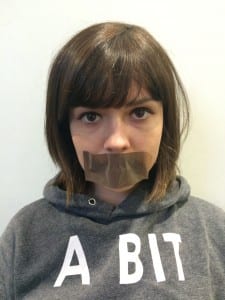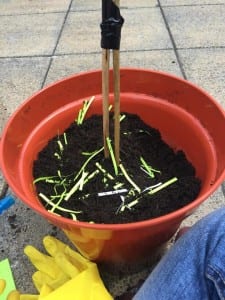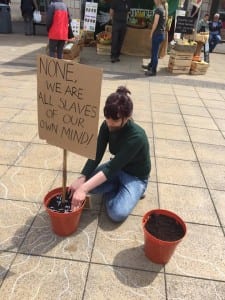Framing Statement
Potted Protest was a piece of site-specific performance art, performed in Speakers’ Corner on the 8th May 2016. The performance was mainly a one-to-one experience lasting around two minutes for each audience-participant, however, around this we created an installation piece for non-participant audience members, lasting for two hours in the space.
Our performance took inspiration from many different artists and theorists. From Adrian Howells, we took the notion of non-verbal transactions and intimacy in one-to-one performances; from Suzanne Lacy we were inspired by the idea of confessional and testimonial installation as a form of catharsis. Dee Heddon informed us about the boundaries between performer and spectator in work such as ours, as well as Cathy Turner’s notion of palimpsest allowing us to delve deeper into the different layers of the space in our work. Situationists provided much of the political fire behind our work, referring to everyday life when discussing revolution, in order for it to become real.
Potted Protest was staged in the Cornhill, a public square adjacent to Lincoln High Street. The north-west corner of the Cornhill was named Speakers’ Corner in 2011, inspired by a Suffragette Rally that took place at the Cornhill in 1908 (Speakers Corner Trust, 2016). This space was not large enough to accommodate our performance, therefore we staged our piece in the large open square just behind this, which provided four different access routes for an audience, as well as sufficient space for a large amount of spectators. The Cornhill is a major public space, being the host of many popular high street chains and banks. As a result, the Cornhill sees a large amount of the footfall of the main Lincoln City Centre. This was very beneficial for us as performers when staging our piece, as we were confident that our performance would impact a great deal of people in the City Centre on that day.

Our piece was inspired by the history of the Cornhill and the creation of Speakers’ Corner as a place for active freedom of speech. The piece examined the lack of use of Speakers’ Corner through provoking questions about the power of the individual, as well as emulating the layers of history of the site: using placards to symbolise the women who stood in the space over one hundred years previous. The answers to the question we asked each audience-participant were written on these placards and placed in the space, creating a live installation of thought over the two hour performance. We explored how ideas can become something more through action by incorporating natural metaphors into the piece such as the spreading of roots and the kneading/watering of soil, showing that if you nurture your ideas, they will grow.
The first development of my site specific performance took place in our early explorations of the Speakers’ Corner site. We were intrigued by the openness of the space, looking much like a stage, perfect for a performance or large-scale demonstration. We researched Speaker’s Corner and found that the creation of the space was “a joint project between the University of Lincoln’s Take Part Programme and the Speaker’s Corner Trust” (BBC, 2010), sited “close to where a suffragette demonstration took place nearly a century ago” (BBC, 2010). Speaker’s Corner was opened by former Labour politician Tony Benn, followed by students from the university “who were among the first people to debate at the site” (BBC, 2010). From this, we knew that the space had roots in the political, and had the potential to be even more politically charged through the right kind of performance. A quote about the opening of Speakers’ Corner said: “This will remind people that we have the right to speak.”
This was an initial eye-opener to us, as a stimulus for a performance. We considered ideas such as recreating a Suffragette Rally, but rather than using placards saying things such as ‘Votes for Women’ focusing on more contemporary issues that still oppress women today. Setting a contemporary demonstration in a place with such rich history of similar themes would echo the ghosts of those women there before us.
Works that inspired this idea included Tambellini’s BLACK ZERO (1965), which incorporated live performance, poetry and projection and had strong revolutionary and social change messages, commenting on the racial situation in America” (Beaven, 2012). Also, Guy Debord’s Society of the Spectacle (1967), inspired by Situationist ideas, which inspired performative strikes from students across Paris. Graffiti appeared around Paris, including the line: ‘Le patron a besoin de toi, tu n’as pas besoin de lui’ (the boss needs you, you don’t need him). This in particular developed my idea around creating a contemporary Suffragette rally, and even allowed me to create an aesthetic for a possible performance:

The text on the banner would be painted on in red (connotations: blood, danger, lust, Communist red) and the balloons would be coated in newspaper clippings (adverts/tabloid headlines symbolising consumption and the public desires) – the balloons themselves, the dress and the stuffed teddy bear present the main figure in the picture to be childlike and innocent (a description of humanity under the Capitalist structure). Whilst still taking elements of a Suffragette rally such as women in the space with banners and placards, I believed a more contemporary, performative twist would bring the piece into the present day and keep it relevant with the women of Lincoln today, whilst still using palimpsest to layer histories on top of one-another.
After further research and experimentation in the space, we sat in Speakers’ Corner and discussed the layers of history, from the Suffragette rally to the present day. Many Suffragettes, after being arrested and imprisoned, went on hunger strikes as it was one of the only forms of protest available to them in a restricted environment. Hunger-striking Suffragettes were force-fed though tubes (either down the nose or throat). This idea of force-feeding and using force/restraint to make people conform reminded us of the idea Situationists discussed about consumer culture and how it is everywhere in modern day society – it is force fed to us, whether we like it or not. This link with the Suffragettes creates a powerful metaphor for people being overpowered and silenced by authority; “the boss” (like the political graffiti in the Parisian riots), in both senses of the word.
One way that we as a group observed this force-feeding of consumer culture in Speaker’s Corner is the use of neon lighting. We found neon lights on the signs for banks, euro exchange, and on the cash machines, all used as a form of advertising – you can’t look away as you can see them out of the corner of your eyes. We also discussed how neon lights are typically used on the outside of places like takeaways and even brothels/strip clubs; all of these things relate to the idea of immediate gratification. A simple transaction can give you what you want instantly, an idea that is promoted through Capitalism. We experimented with the idea of force-feeding by taping over our mouths and having another person in the group feed us, and the impact, both visually and mentally that had.

All of these places of immediate gratification, the corporate chains, and the dancing neon patterns that make up the buildings around Speaker’s Corner violently contrast with the sparse, un-kept square in the middle. From this, we decided to use exchange and transaction as a theme in our final piece. We looked into the work of Adrian Howells, and how he uses transaction in his pieces. In Salon Adrienne (2005), Howells uses dialogical transaction, giving people the opportunity to alleviate guilt, or as he says, “collective catharsis” (Howells, 2010). He allows his audience-participant to know something about him, in return for them telling him something about them.

Howells refers to this type of performance as “confessional” (Howells, 2010), arguing this style of performance reflects the mass-mediated culture we live in. Dee Heddon discusses Howells’ work, and his transactional, one-to-one style, claiming:
“The prevalence of the One to One form and its particular dramaturgical-spectatorial structure prompts interrogation into what it means to be a literally performing spectator.” (Heddon, 2012)
This idea that through one-to-one, intimate transactions, a piece of performance art can rely just as much on the artist as it does on the audience-participant was a notion we were eager to test out. We wondered if in some way, we could blur the boundaries of performer/spectator and ease the audience-participant into a secure state of mind; we were well aware that participating in performance art in a public place would be daunting, so we wanted to be able to connect with whoever took part.
We returned to Speaker’s Corner and experimenting in the space. We did things such as eves-drop in the square and inside the shops, walk around the square picking out small details, and talk to each other from across the space; afterwards we sat and brainstormed ideas. We agreed that we still wanted to use the idea of transactions, given that the space we are in is so focused on money and exchange, yet we also agreed that rather than pinpointing our performance with the specific event of the Suffragette rally, we would look at how that event inspired the creation of Speaker’s Corner, and the intended purpose of it today; inspired by that same quote: “This will remind people that we have the right to speak” (Lincolnshire Echo, 2010).
We researched the work of Suzanne Lacy, a feminist performance artist whose work mainly revolves around women’s rights – in particular, destroying rape culture. Lacy’s Auto on the Edge of Time (1993-94) was: “A series of installations and projects that explored the effects of domestic violence as experienced by women, children and families throughout the United States. The centerpiece [sic] of the project was a collection of wrecked cars transformed by Lacy and her collaborators into sculptural testimonials on themes of escape, abuse, control, support, healing, memorializing and more.” (Lacy, 2015)
Lacy’s use of testimonials added an element of catharsis to her work, much like Howells’, giving an emotional outlet and escape to victims, whilst also displaying a powerful message to others. This form of installation really hit the nail on the head for us in our development process; we wanted to provide catharsis to people whilst also informing. We wanted to be intimate and approachable, giving them something back, whilst also reaching to a wider audience.
We experimented with using placards in the space, seeing how they looked and felt, and how people reacted to them. In terms of a reaction, most people who walked by reacted to the placard in some way. Most simply glanced at it, few stopped to read it. When people walked by us in groups, we realised we’d created a talking point; people were answering the question whether they knew it or not. They were talking about it to each other and giving answers. We wanted these ideas to be shared onto the placards during the performance, and to encourage people to delve into their emotions and share what they truly felt, emulating Howells’ style.


I had the idea of using the placards to also symbolize plants, as they are something that needs nurturing in order to flourish, just like people’s thoughts and emotions. We looked at Howells’ Foot Washing for the Sole (2010) where he bathes and moisturizes the audience-participant’s feet; Howells wanted people to take time out of their lives to be present, exposing their vulnerable feet and “be nurtured and to feel the emotion that brings” (Howells, 2010). In turn, we believed we should nurture the ideas given to us, as they are personal to each audience-participant. I suggested the idea of placing the placards in plant pots filled with soil, which would be watered and looked after, as the roots of that voice being shared would slowly embed into the site (we would do this by drawing chalk roots onto the floor).
Our development process was starting to come to an end, and what we were left with was the inner-workings of a performance. We just needed to perfect this idea of intimate transaction. We made the decision to make our performance a one-to-one experience, so that the audience-participant would feel more at ease and more nurtured and valued by us as artists. We had brought the piece closer to Howells, our main influence. One at a time, an audience-participant would come up to the table, sit, and make eye contact. At which point, the artist sat at the table would produce a piece of paper with the first set of instructions on it; the audience-participant reads it; they make eye contact; they are handed the question and paper/pen; they write; they are given the last set of instructions; they are given a card; they put their answer into one of the two boxes; they leave; the next person sits down, and so on.
This one-to-one experience gives the piece a much more personal feel, and delivers the idea we strove to achieve of making the audience feel connected to the piece in a deeper way, allowing them to give much more honest answers. The audience-participant feels valued and are given time away from their lives for a couple of minutes to engage in collective catharsis, just as Howells does. Mike Pearson says that those present as contributors possess “agency” (Pearson, 2010), supporting Heddon’s view that audience-participants “have the right to write and rewrite their location and, as such, to rewrite the script” (Heddon, 2007); this is the idea we wanted to create, to give the audience the freedom to shape the piece as artists themselves, blurring the boundaries, and creating an installation that could not be predicted by us. The idea of non-verbal conversations that Howells uses is also present in our piece through the use of eye contact – not only does our lack of speech and purely aural communication tell the audience we are taking a step back (this is not about us, but about them), but allows them to search deeper into themselves via an intimate experience, just like Howells’ strives to achieve in his piece The Pleasure of Being: Washing, Feeding, Holding (2011).
Performance Evaluation
Our final performance saw us set up two wooden chairs in Speakers’ Corner, facing each other. In between the tables was a wicker basket, on top of which was a jar, a hand-held shredder, paper, pens, and cards. I sat in one chair, the chair opposite remained empty for an audience-participant, with blackboards around it saying ‘please take a seat’. As an audience-participant sat down, I would hand them a piece of paper which read:

Once the audience-participant had let me know they had finished reading by making eye contact, I would then exchange that piece of paper for another that read:

They would write their answer to this question on a piece of paper and either put it in the jar to protest it, or shred it themselves. I would hand them a card with the link to a blog site on it: speakerscorner.blogs.lincoln.ac.uk/about-speakers-corner. This blog site has information about Speakers’ Corner, our performance, and documentation of all the placards as a form of preservation. If an audience-participant put their answer in the jar, I would write their answer onto a placard in black ink and hand it to Chloe. Chloe’s role was to plant the placards and nurture them, watering them and slowly drawing roots coming from the plant pots onto the floor with chalk. This was an embodiment of the voices being rooted in the space. Emily’s job was using the shreds to create compost, mixing them with the mud around the planted placards, helping them to grow with the thoughts that never became words – all ideas are valuable.
I believe our performance was very successful, drawing in a large crowd of people, and gaining many audience-participants. Hearing people standing around watching our piece, many were discussing what they thought it meant; whilst some were along the right lines, others had much more elaborate ideas. We didn’t mind so much, as we knew everyone would take something different from this performance. However, if we were to repeat it, not only would we use more placards, but we’d find a way to make the message clearer to audience members not directly involved, as our goal to inspire people to use the space was not attained by all, as our piece perhaps didn’t visually convey enough information about the site it was in to a passer-by. The placards worked very well as an installation, causing people to stop and read them. The roots were visually appealing, particularly after the performance had been packed away, acting as a reminder to those who saw, and a question to those who didn’t. Here are some photos of the final performance:





(Word Count: 2,641)
Works Cited
BritishCouncilArtsSg (2010) Adrian Howells . Available from https://www.youtube.com/watch?v=C7btf8Tdg_s [accessed 28 March 2016].
BBC (2010) Tony Benn has officially opened Speakers’ Corner. Available from http://news.bbc.co.uk/local/lincolnshire/hi/people_and_places/newsid_8872000/8872171.stm [accessed 5 February 2016].
Beaven, K (2010) Performance Art 101: The Angry Space, politics and activism. London: Tate. Available from http://www.tate.org.uk/context-comment/blogs/performance-art-101-angry-space-politics-and-activism [accessed 5 February 2016].
Debord, G. (1967) Society of Spectacle. Paris: Buchet-Chastel.
Heddon, D. (2007) Autobiography and Performance: Performing Selves. Basingstoke: Palgrave Macmillan.
Heddon, D., Iball, H. and Zerihan, R. (2012) Come Closer: Confessions of Intimate Spectators in One to One Performance. Contemporary Theatre Review, 22(1) 120-33.
Lincolnshire Echo (2010) Speakers Corner given official new home in Lincoln’s High Street. Available from http://www.lincolnshireecho.co.uk/Freedom-speech-new-home-Lincoln-High-Street/story-11200935-detail/story.html [accessed 5 February 2016].
Offwestend.com (2013) Picture of Salon Adrienne [image]. Available from http://www.offwestend.com/index.php/plays/view/10335 [accessed 8 May 2016].
Pearson, M. (2010) Site Specific Performance. Basingstoke: Palgrave Macmillan.
Speakers’ Corner Trust (2016) Identifying The Speakers’ Corner Site. Available from: http://www.speakerscornertrust.org/speakers-corner-projects/uk-projects/Lincoln/ [accessed 20 April 2016].
Tambellini, A. (1965) BLACK ZERO [performance]. New York, NY: The Bridge Theater, 15 December.